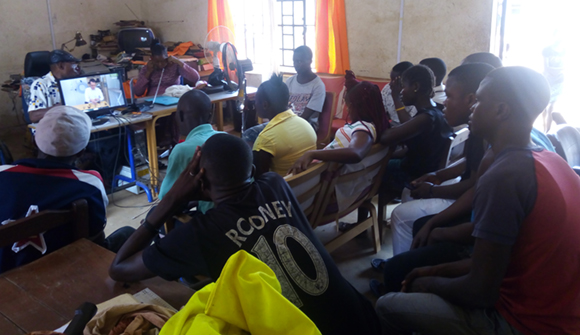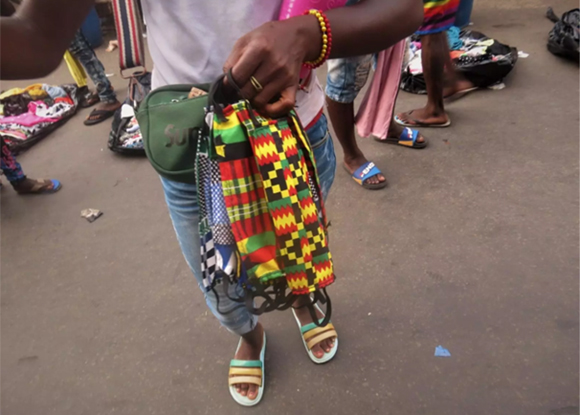
SDU and Engineers Without Borders provide face masks in Africa
Scientists from the Maersk Mc-Kinney Moller Institute and the Department of Clinical Research at SDU have initiated a collaboration with Engineers Without Borders to produce and distribute face masks in Sierra Leone and Guinea-Bissau. The purpose is to limit contamination of COVID-19 and test the effectiveness of the masks.
In an apartment in central Odense sits a 39-year-old drone scientist with sore hands. His name is Dylan Cawthorne. Besides being an associate professor at the SDU Drone Center, he is also a talented clothing designer.
This past week he has sewn face masks round the clock to develop an effective prototype of a mask that can be produced and distributed in Sierra Leone and Guinea-Bissau.
The aim is partly to reduce the contamination of COVID-19 in the two countries, but also to test how effective the fabric masks are.
Local tailors
Dylan Cawthorne thus plays an important role in the large-scale face mask project, which the Maersk Mc-Kinney Moller Institute and the Department of Clinical Research at SDU have initiated in Africa in collaboration with Engineers Without Borders.
In the coming weeks and months, around 100,000 citizens in Guinea-Bissau alone will be provided with face masks. The masks will be produced with local materials and by local tailors via online tutorials from SDU.
They will be distributed in villages and local societies and the use of them will be tested clinically at the research station Bandim Health Project, where SDU is already located.
Flattening of the curve
It was Dylan Cawthorne’s drone colleague, associate professor Kjeld Jensen,
who initially got the idea.
Kjeld is already conducting projects on water supply in Sierra Leone, and
for several years he has also been active within Engineers Without Borders.
He has also been deployed by Red Cross internationally and has a strong
understanding of the challenges facing the African continent.
- As the debate about face masks took off in Denmark, I thought to myself that we might be able to help with this in Africa, Kjeld Jensen says.
”Even though there is no scientific consensus about the effectiveness of masks, it is my professional assessment that the use of masks will help limit the contamination and slow down the transmission of COVID-19.
He quickly contacted Engineers Without Borders and Christine Stabell Benn, who is a professor in Global Health at the Department of Clinical Research and leader of the Bandim Health Project. As soon as Christine got the call from Kjeld, thought to action happened quickly.
- I immediately saw the idea in this project, tells Christine Stabell Benn.
- Even though there is no scientific consensus about the effectiveness of masks, it is my professional assessment that the use of masks will help limit the contamination and slow down the transmission of COVID-19. A flattened curve will have a great significance for African countries, where the healthcare systems are not equipped to take in many patients at the same time.
Sewn from African cotton
Fabric masks are not all equal. Their effectiveness depends largely on how they are sewn, what shape they have, how they are constructed, and what materials are used.
Since the masks in the project will be produced by local tailors and with local materials, it was important that Dylan Cawthorne’s prototype took this into account.
Luckily, Christine Stabell Benn had two shirts made of African cotton in her wardrobe. She dropped them off in front of Dylan’s front door in Odense and he then started to cut, sew, and develop the prototype. One of the first things he did, was to check the construction of the fabric through a microscope to assess the density.
Tight and comfortable
- I’m happy to contribute to this, and I find it very interesting to combine my two interests of engineering and sewing, tells Dylan Cawthorne.
- It is important that the masks are tight enough to stop drops of infection. At the same time, it needs to be comfortable enough to wear. It took me many hours at the sewing machine to perfect the design.
The team behind the project expects that one tailor can produce six masks every hour. This way, production can be quickly scaled up.
Tested by FORCE Technology
In addition, FORCE Technology has offered to collaborate with tests of the mask. This will help the team understand the quality, and how fabric masks perform compared to common medical masks.
- This is a good non-profit initiative, and we’re happy to be able to contribute, even though we are very busy, says Henrik Lindeløv, Head of Department at FORCE Technology.
Pleased with SDU cooperation
At Engineers Without Borders, secretary-general Dorte Lindegaard Madsen is pleased with the SDU collaboration.
- We have come together to solve a serious and urgent problem, and we are proud to be a part of this. It is spot on for us to contribute to the production of protective equipment for the civilian population. With SDU as a partner, there is a strong interdisciplinary foundation behind the project. It makes good sense that we try to solve this jointly, she says.
While clinical trials are to be conducted in Guinea-Bissau and led by SDU, it is Engineers Without Borders who has the main responsibility for the production and distribution in Sierra Leone.

- 70 people in a technical college for disabled students in Sierra Leone are already sewing the first masks by following Dylan’s instructions, and we have a great number of other collaborators who will soon be involved, tells Dorte Lindegaard Madsen.
Major clinical study
The research station Bandim Health Project in Guinea Bissau has followed the population since 1978 with a focus on health and illness. As many as 100,000 people are being closely followed, with researchers focusing largely on vaccines and mortality.
It is these people who will now be provided with the masks, at different intervals, so that Christine Stabell Benn and other scientists can demonstrate to what extent the protection of masks effects the rate of sickness and mortality of COVID-19.
A research protocol, drawn up in collaboration with local partners in Guinea-Bissau, is currently being approved by the Ethics Committee, and as soon as it is in place, and funding has been secured, the project will take off.

- The special thing about Dylan’s mask is that it sits close to the face. This means that it presumably gives far better protection than scarfs and simpler masks. Now we need to investigate how many particles it removes and how it works in the local community.
- Hopefully, it will lead to fewer people getting sick at the same time. We also hope to gain more knowledge about the effect of masks, concludes Christine Stabell Benn.
The next steps
In the coming weeks, researchers from SDU and voluntary engineers from Engineers Without Borders will continue to work on the development of the mask and test methods. Meanwhile, they must secure the economy.
- We have put in many hours in the project, and our joint e-meetings are held both in evenings and weekends. It is fantastic to experience the energy and creativity that has emerged from the interdisciplinary collaboration between doctors and engineers. Everyone is making an extra effort to contribute to reducing the infection in the African countries. Now, we are looking for a fund or a donor, who will work with us to complete the clinical study, concludes Kjeld Jensen.
The prototype
Dylan Cawthorne’s prototype of a facial mask is developed with inspiration from other available patterns. It is built up from multiple layers of African cotton. Besides, it has a nose brace which is made of the type of metal that is to be found in paper clips. Engineers Without Borders has produced an instructional video with Dylan Cawthorne showing how to make the masks.
- Read about SDU Unmanned Aerial Systems (UAS) Center
- The Maersk Mc-Kinney Moller Institute
- Faculty of Engineering
- Department of Clinical Research
- Faculty of Health Sciences
Meet the researcher
Kjeld Jensen is an associate professor at SDU Drone Center and the one, who initially came up with the idea for this project. He has worked with Engineers Without Borders and the Red Cross for years and is currently managing the Health Drone-project in collaboration with OUH and others.
Meet the researcher
Dylan Cawthorne is an associate professor at the SDU Drone Center. Originally from Alaska, his research is centered around ethics and value sensitive design. He is also involved in the Repair Café in Odense and likes to design and sew his own clothing.
Meet the researcher
Christine Stabell Benn is a professor in Global Health the Department of Clinical Research at SDU. She is also the Danish leader of the Bandim Health Project in Guinea-Bissau.